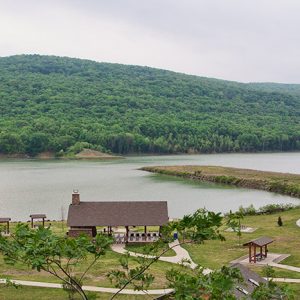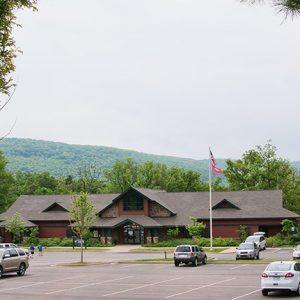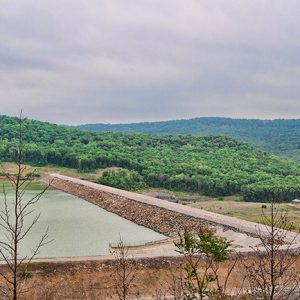calsfoundation@cals.org
Lake Fort Smith State Park
| Location: | Crawford County |
| Area: | 260 acres |
Although it first became a state park in 1967, making it Arkansas’s twenty-third state park, the opening of Lake Fort Smith State Park in the spring of 2008 in a new location with entirely new facilities made it the newest of Arkansas’s state parks. At the park’s official dedication on June 19, 2008, park officials and local leaders celebrated the site that overlooks Lake Fort Smith and that in many ways reproduces the environment of the earlier park.
The park was originally developed in the late 1930s as a city recreational park when Crawford County, along with the City of Fort Smith (Sebastian County) decided to utilize Lake Fort Smith as a tourism destination, called the Mountainburg Recreational Facility, as well as a source of drinking water. The recreational facility and water plant were under construction at the same time. The original facilities were a Works Progress Administration (WPA) project. Workers constructed a wading pool, a large swimming pool with two diving towers, four stone veneer cottages, a new road to the pool facility, an arched bridge, a bathhouse, several fish ponds, a boathouse, bridle paths, and landscaping. WPA crews also cleared underbrush and built barbecue pits, shelters, stone tables, and rock houses around the springs along the mountainside.
The Arkansas State Parks system took over the Mountainburg Recreational Facility in 1967 and immediately began upgrades. The pool had been closed since 1963 because the Arkansas Department of Health disapproved of the unfiltered water from Lake Fort Smith being pumped into the facility. The state built a new Olympic-sized pool and remodeled the bathhouse and concession stand. The state also purchased new playground equipment and fireplace grills and constructed a small campground.
While numerous upgrades had been accomplished at the park over the years, the original park facilities were located in the area that included Lake Fort Smith Dam’s enlargement and its associated spillway. Lake Fort Smith and Lake Shepherd Springs were enlarged to meet increased municipal water demands in the Fort Smith area, and they form a single reservoir totaling 1,390 surface acres. The new dam was completed in the summer of 2006. It stands 190 feet tall—101 feet higher than the previous dam. The expansion of the reservoir is expected to satisfy the area’s anticipated water demands through the year 2050.
The old state park was closed on January 2, 2002. The City of Fort Smith paid $12 million to replace the state park’s amenities at the new location, and the Arkansas State Parks system added $10 million for additional features, the money coming from the one-eighth-percent conservation sales tax approved by voters in 1996 as Amendment 75. The new facilities include an 8,000-square-foot visitor center built of stone and timber in imitation of the WPA buildings of the old park. The park also features a group lodge that can house up to thirty-two guests, as well as thirty campsites, a large lakeside pavilion with picnic tables, a playground, a marina, and a boat ramp. Next to the visitor center are a 2,660-square-foot swimming pool and a 2,251-square-foot bathhouse.
Lake Fort Smith State Park serves as the western terminus for the Ozark Highlands Trail.
For additional information:
Arkansas State Parks–Lake Fort Smith. http://www.arkansasstateparks.com/lakefortsmith/ (accessed August 24, 2022).
“Fort Smith Park Closes Jan. 2, Opens Elsewhere in ’04.” Arkansas Democrat-Gazette, December 22, 2001, p. 7B:3.
Hamilton, Joe. “Water for the Future: Building Lake Fort Smith.” Journal of the Fort Smith Historical Society 40 (April 2016): 3–8.
Robinson, Bob. “A Reservoir of Fun.” Arkansas Democrat-Gazette, June 10, 2024, pp. 1D, 6D. Online at https://www.arkansasonline.com/news/2024/jun/09/conceived-and-built-by-the-wpa-in-the-1930s-lake/ (accessed June 10, 2024).
Staff of the Arkansas Department of Parks and Tourism
Staff of the CALS Encyclopedia of Arkansas









Comments
No comments on this entry yet.